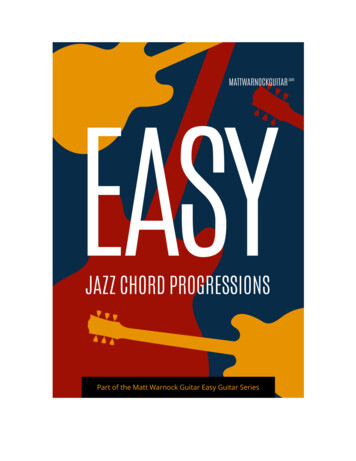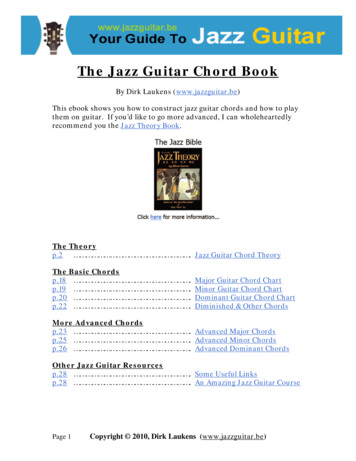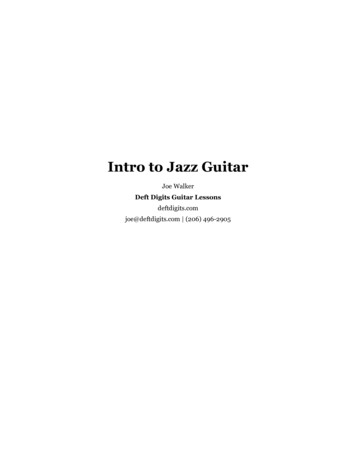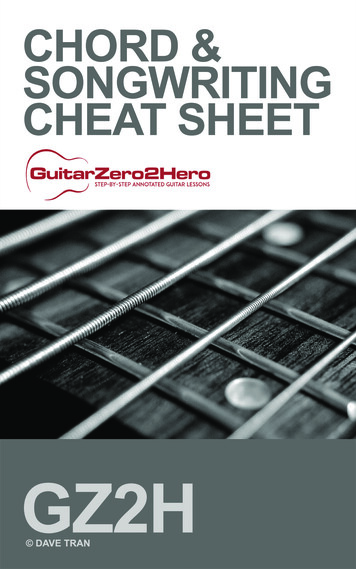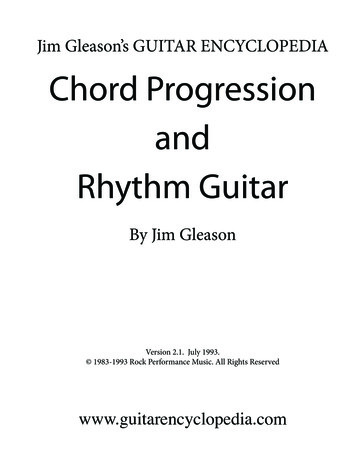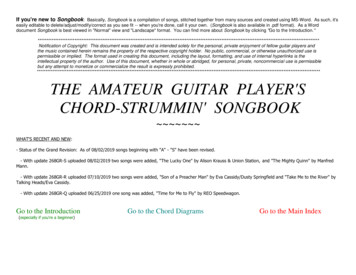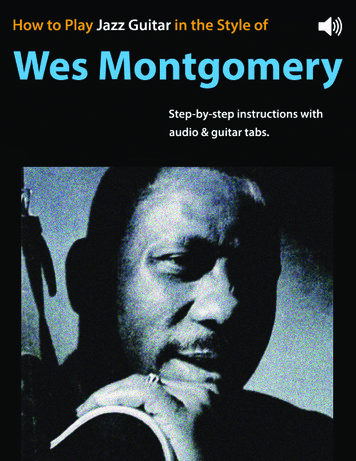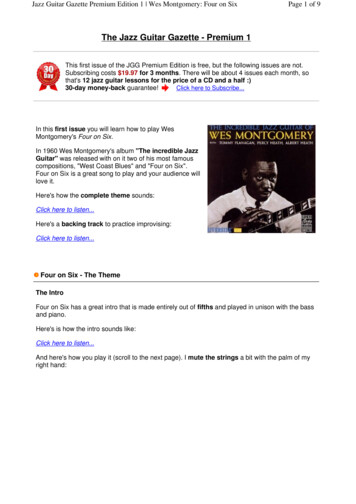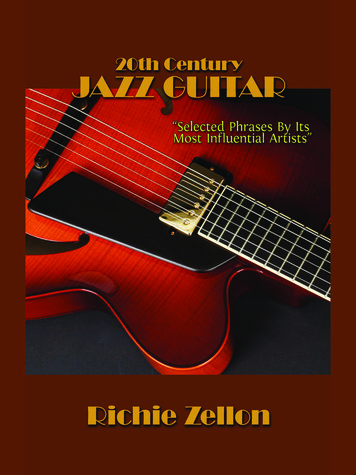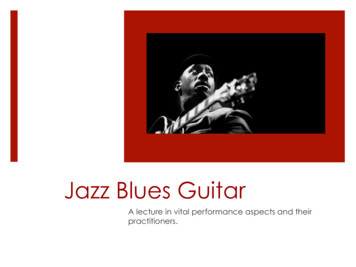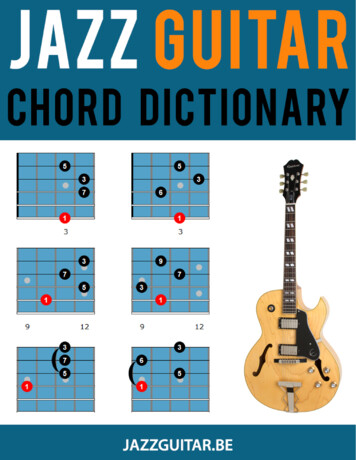
Transcription
ITAR.BE
THE JAZZ GUITAR CHORD DICTIONARYThis jazz guitar chord dictionary is a reference to help you find great-sounding 7thchord voicings to play and improvise over jazz standards. The 244 chord shapes onthis page are essential knowledge for any jazz guitarist and will help you to compchords with creativity, confidence, and variety.Now, you don’t have to learn all of these chords at once. Instead, use this page as aresource that you come back to each time when you need to add a new chord to yourvocabulary.Have fun with these chords, get them under your fingers, and most importantly, applythem to jazz standards and chord progressions as soon as you can.Happy Playing,Dirk LaukensPS: If you are new to jazz guitar, check out these basic jazz guitar chords first.
CHORD TYPE LIST1How To Read Chord Diagrams2Basic ChordsMajor 7 ChordsDominant 7 ChordsMinor 7 ChordsHalf-Diminished ChordsDiminished 7 Chords3Shell Chords (aka Guide Tone Chords)137 Shell Chords (E-String Root)173 Shell Chords (E-String Root)137 Shell Chords (A-String Root)173 Shell Chords (A-String Root)4Chords With ExtensionsMajor 6Major 6(9)Major 9Major 13Major 7#11Major 7#5Dominant 9Dominant 13
7 Sus 4 Chords9 Sus 4 Chords13 Sus 4 ChordsMinor 6Minor 9Minor 11Minor/Major 7Minor/Major 95Dominant Chords Altered ExtensionsDominant 7b97b9 Sus4Dominant 13b9 / Dominant 13#9Dominant 7#9Dominant 7#11Dominant 7b13Dominant 7 Altered - 7b5(b9)Dominant 7 Altered - 7b5(#9)Dominant 7 Altered - 7#5(b9)Dominant 7 Altered - 7#5(#9)6InversionsMajor 7 Inversions (Drop 2) – A-String Bass NoteMajor 7 Inversions (Drop 2) – D-String Bass NoteMajor 7 Inversions (Drop 3) – E-String Bass NoteMajor 7 Inversions (Drop 3) – A-String Bass Note
Dominant 7 Inversions (Drop 2) – A-String Bass NoteDominant 7 Inversions (Drop 2) – D-String Bass NoteDominant 7 Inversions (Drop 3) – E-String Bass NoteDominant 7 Inversions (Drop 3) – A-String Bass NoteMinor 7 Inversions (Drop 2) – A-String Bass NoteMinor 7 Inversions (Drop 2) – D-String Bass NoteMinor 7 Inversions (Drop 3) – E-String Bass NoteMinor 7 Inversions (Drop 3) – A-String Bass NoteMinor 7b5 Inversions (Drop 2) – A-String Bass NoteMinor 7b5 Inversions (Drop 2) – D-String Bass NoteMinor 7b5 Inversions (Drop 3) – E-String Bass NoteMinor 7b5 Inversions (Drop 3) – A-String Bass Note7Open VoicingsOpen Chords With E RootOpen Chords With A RootOpen Chords With D RootOpen Chords With B RootOpen Chords With Bb RootOpen Chords With C Root8Quartal ChordsQuartal Chords Based on the C Dorian Scale (String Set 2-3-4-5)Quartal Chords Based on the C Dorian Scale (String Set 1-2-3-4)9More Guitar Chord Lessons
How to Read Chord DiagramsA red circle represents the root (aka 1) of the chord. Most chords in this dictionaryhave a C root.The black circles are the other notes of the chord. The numbers inside the blackcircles indicate the chord tone.The numbers (1, 2, 3, and 4) at the right side of each chord diagram indicate whichfingers to use to fret the chord.The X symbol at the left side of the chord diagram indicates that those strings are notto be played. This means that most of the chords on this page cannot be strummed,but should be played fingerstyle, with your thumb and first 3 fingers of the right hand.The O symbol at the left side of the chord diagram indicates that those strings areplayed open.
Movable ChordsMost of the chords on this page are of the movable type (not the open chords though).By moving the chord shapes up or down the guitar neck, you get other chords of thesame chord type.For example: move the chord shape of a Cmaj7 voicing 2 frets higher and it becomes aDmaj7 voicing.
1. Basic Jazz Guitar ChordsThe first group of jazz chords is called "basic", but they should really be described as"essential".These shapes contain both drop 2 and drop 3 chords in root position, which is the bestplace to get started playing jazz guitar chords.You will learn smaller shapes in the next section, which are easier to play, but thesefour-note shapes drill the sound of jazz into your ears better than the smaller shapes.Start by learning one shape for each chord type then take those changes to a jazz tuneyou know or are working on.Here are 10 great songs to practice and apply these chords to:Autumn LeavesSummertimeAll The Things You AreFly Me To The MoonBlue BossaThere Will Never Be Another YouGeorgia On My MindTake 5The Girl From IpanemaMy Funny Valentine
Major 7 Chords
Dominant 7 Chords
Minor 7 Chords
Minor 7b5 (Half-Diminished) Chords
Diminished 7 Chords
2. Shell ChordsShell chords (aka guide tone chords) are often referred to as Freddie Green chords, ashe used them to create his iconic rhythm sound with the Count Basie band.These three-note chords contain the root, 3rd, 7th (or the 6th) of each chord.Because of this, you hit the essential chord tones for each shape, and mostly on thelower string sets.Since these shapes are lower on the neck than other chord shapes, you need to keepyour tone in mind so you don’t clash with the bass player in your playing.With a soft tone, these chords are highly effective when comping in a duo, trio, orlarger ensembles.
1 3 7 Shell Chords (E-String Root)
1 7 3 Shell Chords (E-String Root)
1 3 7 Shell Chords (A-String Root)
1 7 3 Shell Chords (A-String Root)
3. Chords with ExtensionsExtended chords use intervals outside of the root, 3rd, 5th, and 7th in theirconstruction.Because of this, we often describe these chords as more "colorful" compared to morebasic jazz guitar chords.Because we don’t have 10 fingers to play chords as a pianist would do, guitarists haveto leave some notes out when adding extended notes to their chord shapes.Keep that in mind, and notice which notes are replaced as you add these fun chordshapes to your harmonic vocabulary.Major 6 chords and major 6(9) chords, the first two types of extended chords in thisset, are different from the extended chords that follow because they don't contain a 7.All the other extended chords (such as maj9), contain the 7th in their construction.In a major 6 chord, the 6 replaces the 7:When a 6 and a 7 are both present in a major chord, it becomes a major 13 chord.Major 13 chords contain both the 7 and the 6 ( 13), as opposed to major 6 chords,where the 7 is omitted.
Major 6 Chords
Major 6(9) Chords
Major 9 Chords
Major 13 Chords
Major 7#11 Chords
Major Augmented (Major #5) Chords
Dominant 9 Chords
Dominant 13 Chords
7 Sus 4 Chords
9 Sus 4 Chords
13 Sus 4 Chords
Minor 6 Chords
Minor 9 ChordsMinor 11 Chords
Minor/Major 7 Chords
Minor/Major 9 Chords
4. Dominant Chords with Altered ExtensionsBesides the normal extensions (9-11-13), dominant chords can handle alteredextensions as well, such as b9, #9, #11, and b13.In this section you look at dominant chords with altered extensions.These chords can be used over any dominant 7th chord in your comping to createextra tension, but if you’re new to these sounds start with using them in minor keys.For example, if you have a minor ii V I chord progression (Dm7b5-G7-Cm7), you canuse altered extensions over the G7 chord.These extensions are supposed to sound tense and create tension, so if they sound“weird” to you, not a problem.Work with them, and over time those outside notes will start to sound normal andmore natural to your ears.
A lot of people are confused about the difference between extensions #11 and b5.Both are the same note, an f# ( gb) in C7.A C7 with a #11 usually contains a natural 9 (d) because this chord is derived from theLydian dominant scale (4th mode of the melodic minor scale). A C9#11 often functionsas a bVII7 going to Imaj7 (C7#11 to Dmaj7, for example):A C7 with a b5 contains a b9 or #9 because this chord is derived from the altered scale(7th mode of the melodic minor scale). A C7(b5,b9) often functions as a V7alt going to Im7 or Imaj7 (C7b5b9 going to Fm7 or Fm9, for example):
Dominant 7b9
Dominant 7b9 Sus 4
Dominant 13b9 / Dominant 13#9
Dominant 7#9
Dominant 7#11
Dominant 7b13
Altered - 7b5(b9)Altered - 7b5(#9)
Altered - 7#5(b9)Altered - 7#5(#9)
5. Chord InversionsChord inversions use other notes in the bass than the root note.Notice that for each group of chords, the root is in the bass for the first chord shape,then the 3rd, 5th, and the 7th after that.Each of these chord inversions can be applied to that chord in your comping. Forexample, if you see a Cmaj7 chord symbol you can play any inversion of Cmaj7.Just know that each inversion will have a slightly different sound and some voicings willwork better than others.Though they use the same notes, putting the root or the 3rd in the bass causes thechord to have a slightly different flavor.
Major 7 Inversions (Drop 2) - A-String Bass NoteMajor 7 Inversions (Drop 2) - D-String Bass Note
Major 7 Inversions (Drop 3) - E-String Bass NoteMajor 7 Inversions (Drop 3) - A-String Bass Note
Dominant 7 Inversions (Drop 2) - A-String Bass NoteDominant 7 Inversions (Drop 2) - D-String Bass Note
Dominant 7 Inversions (Drop 3) - E-String Bass NoteDominant 7 Inversions (Drop 3) - A-String Bass Note
Minor 7 Inversions (Drop 2) - A-String Bass NoteMinor 7 Inversions (Drop 2) - D-String Bass Note
Minor 7 Inversions (Drop 3) - E-String Bass NoteMinor 7 Inversions (Drop 3) - A-String Bass Note
Minor 7b5 Inversions (Drop 2) - A-String Bass NoteMinor 7b5 Inversions (Drop 2) - D-String Bass Note
Minor 7b5 Inversions (Drop 3) - E-String Bass NoteMinor 7b5 Inversions (Drop 3) - A-String Bass Note
6. Open ChordsOpen chords use open strings in their construction.Though they are limited to a few keys, these shapes add new flavor to your comping inparticular key centers. Open chords have a specific sounds that is unique to the guitar.Have fun with these open string chords and use them the next time you find yourselfin one of these guitar-friendly keys.
Open Chords With E Root
Open Chords With A Root
Open Chords With D RootOpen Chords With B Root
Open Chords With Bb RootOpen Chords With C Root
7. Quartal ChordsQuartal chords (aka 4th chords) are built by stacking 4th intervals above the lowestnote of the chord.These chords were made popular by McCoy Tyner (John Coltrane’s piano player) andBill Evans (for example on Miles Davis’ standard So What from the album Kind of Blue).Quartal chords sound more open and modern compared to other chord types and canbe used over any jazz standard in your comping and solos.Give these chords a try and don't worry if they sound a bit "too modern" in thebeginning.Over time they will become more natural to your ears and you will be able to applythese shapes to your playing more comfortably.
Quartal Chords Based on the C Dorian Scale (String Set 2-3-4-5)Quartal Chords Based on the C Dorian Scale (String Set 1-2-3-4)
More Jazz Guitar Chord Lessons1Jazz Guitar Lessons2Jazz Guitar Chord Lessons3Jazz Chord Progressions417 Basic Jazz Guitar Chords for Beginners5Jazz Blues Chord Progressions6Gypsy Jazz Chords7Jazz Guitar Rhythms8Jazz Guitar Chord Theory920 Ways to Play II V I Chord Progressions10 Essential Jazz Guitar Chord Exercises11 How to Play 6 Chords12 Major Jazz Guitar Chords13 Minor Jazz Guitar Chords14 Dominant Jazz Guitar Chords15 Diminished Jazz Guitar Chords
16 Minor/Major 7 Chords17 Augmented Major 7 Chords18 How to Read Jazz ChordsTo learn more about jazz guitar chords, check out The Easy Guide to Jazz Guitar Chordsand The Easy Guide to Chord Melody, or buy them in The Easy Guide 3 eBook Bundle.
Click & subscribe here to get new video updates via YoutubeClick & like here to get updates via FacebookClick & follow here to get news via Twitter
THE JAZZ GUITAR CHORD DICTIONARY This jazz guitar chord dictionary is a reference to help you find great-sounding 7th-chord voicings to play and improvise over jazz standards. The 244 chord shapes on this page are essential knowledge for any jazz guitarist and will help you to comp chords with creativity, confidence, and variety. Now, you don’t have to learn all of these chords at once .
